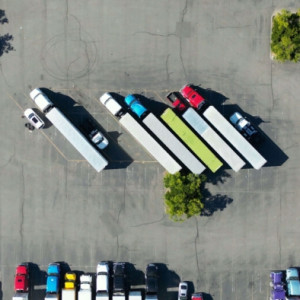Urbiotica: Truck Rest Areas


Transporting goods from one place to another is essential for the global economy, but the logistics behind this process often go unnoticed. To ensure the safety and well-being of professional drivers, routes must be well-planned and include rest areas where they can take safe and comfortable breaks. This not only improves their quality of life but also reduces road risks and enhances freight transport efficiency.
Common Issues in Truck Rest Areas
For truck drivers, finding a suitable place to rest can be a real challenge.
Overcrowding in rest areas is a recurring issue, especially in high-traffic regions or during peak hours. Why does this happen? Some key reasons include:
1.
High demand and time pressure
The rise of e-commerce and globalization has significantly increased freight transport activity. As a result, many drivers push their driving hours to the limit to meet deadlines, reducing their flexibility to take breaks at less congested times. This concentration of trucks in specific locations creates
significant bottlenecks.
2.
Lack of route planning
The absence of real-time tools that provide information on available parking spaces forces drivers to improvise. Many rely on familiar or strategically located stops, leading to overcrowding in some areas while others remain underutilized.
3. Insufficient infrastructure
Many rest areas lack the capacity to meet current demand, and some do not provide essential services for truckers.
As a result, drivers struggle to find suitable parking, leading to violations of parking regulations, competition for limited spaces, or parking in unsafe locations.
The Impact of Overcrowding: Beyond Logistics
The lack of sufficient rest areas affects not only truck drivers but also the entire transport network and the surrounding environment. The main consequences include:
- Increased risk of accidents: Fatigued drivers have slower reaction times, putting themselves and other road users at risk.
- Stress and reduced productivity: The frustration of not finding available parking affects drivers' well-being, reducing their concentration and efficiency.
- Traffic disruptions: Illegal parking and unsafe maneuvers complicate traffic flow and increase the likelihood of road incidents.
- Higher environmental impact: Unnecessary driving in search of parking increases fuel consumption and CO? emissions, worsening the transport sector's environmental footprint.
Technology as a Solution for Rest Areas
Digitalization has proven to be key in transforming the management of service areas. At Urbiotica, we develop smart systems that allow drivers to check real-time parking availability, making route planning more efficient.
Thanks to this technology, drivers can reduce stress, minimize search times, and ensure more effective rest breaks. Moreover, the development of artificial intelligence algorithms will soon enable predictive occupancy forecasting, analyzing historical usage data. Factors such as time of day, day of the week, local events, and even weather conditions will be taken into account to provide accurate and proactive information.
Mowiz Truck: A Benchmark Model
A clear example of successfully implementing these technologies is Mowiz Truck, which has transformed its rest areas into a model to follow.
With round-the-clock security, spacious parking spots, and amenities such as showers and laundry facilities, these locations provide truck drivers with everything they need for a comfortable and secure rest. This approach demonstrates how combining advanced technology with user-focused services can make a real difference.
Towards More Sustainable and Efficient Transport
Optimizing rest areas is not just about driver comfort. It is also essential for improving road safety, reducing the environmental impact of transport, and ensuring smooth logistics operations.
At Urbiotica, our smart parking solutions adapt to all types of infrastructure. With immediate results and a scalable design, our systems provide truck drivers with the peace of mind of having access to real-time, reliable information. We are committed to making roads safer, more sustainable, and more efficient for everyone.
About Urbiotica
Urbiotica[1] was born in 2008 with the mission to bring the most innovative technology to society through urban environments.
Its vision is to help cities become more manageable, efficient, and sustainable, improving the quality of life of its citizens.
At Urbiotica, we focus on developing reliable IoT technologies that enhance urban mobility.
Our sensors are rigorously tested to deliver high performance and accuracy in parking space management, ensuring efficient and dependable solutions.
References
- ^ Urbiotica Profile (www.parking.net)
